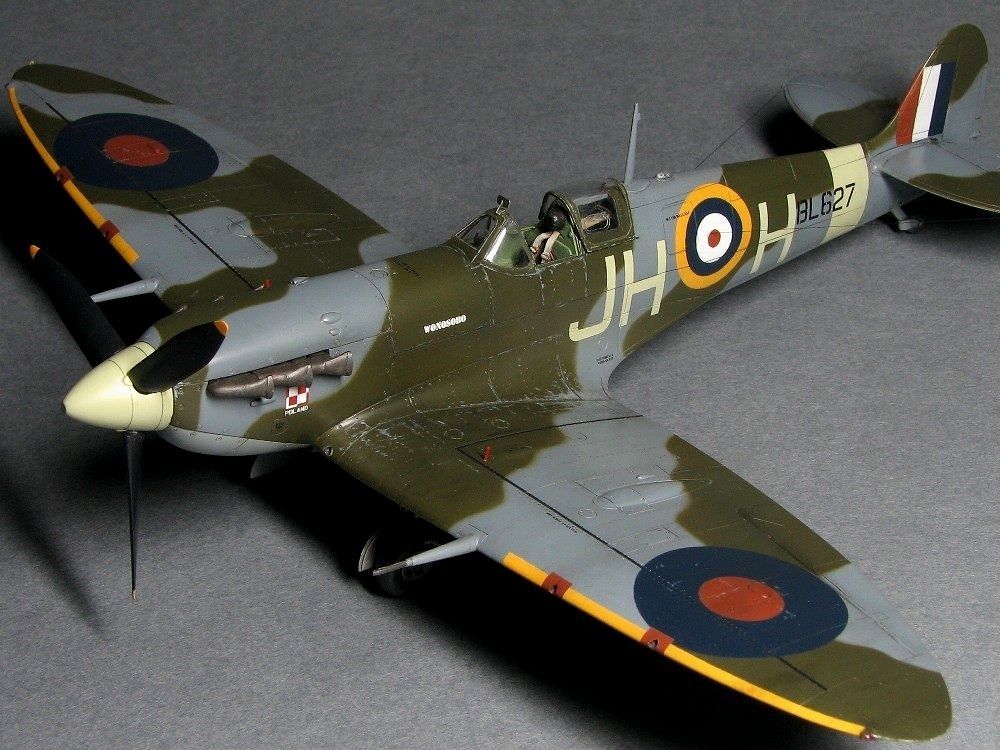
Spitfire Mk.Vb Airfix 1/48
Last update 8/4/2016
 |
|
The long-awaited Airfix's new tool 1/48 Spitfire Mk.V is highly excellent kit. The particularly notable point is its nose cowl. The acciracy of its shape is the highest of any scale kit of early Merlin model. For example, Tamiya 1/48 kit's upper cowl is exaggerated the presence of engine cylinder head. Moreover, dimensions or shapes of the fuselage, cross section, wing, empennage and airfoil are accurate. The box contains many variation parts: early or late windscreen and canopy, normal or trop air-intake, DeHavilland or Rotol prop and spinner, straight of fish-tail exhaust etc. I selected early windscreen, normal intake, long spinner and Rotol prop. That is the characteristics of the early production of Castle Bromwich Aircraft Factory temperate model.
Prior to the construction, I made drawings of Mk.Vb using a set of factory drawings. These factory drawings contain ordinate tables of fuselage and wing. I carefully read drawings and translated to my drawings.
|
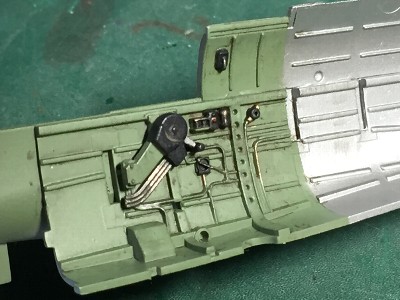 At the beginning, the lower side wall was glued on the fuselage side. |
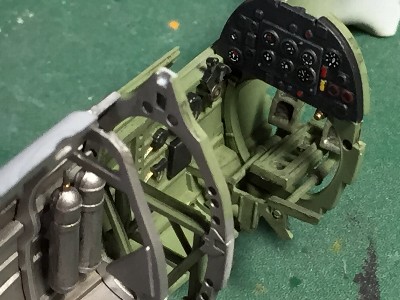 The cockpit was almost straight from the box. |
|
|
 Left and right half parts were glued. The outline shape of upper cowl is very good in this angle. |
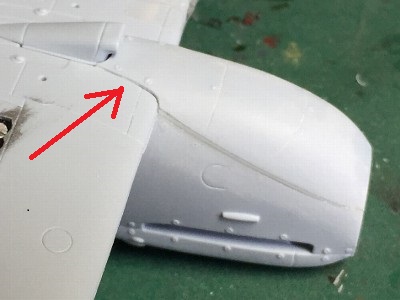 The thin shim was inserted between lower cowl and side cowl so as to let down the lower surface of cowl end by 0.5mm (0.02"). The edge of lower wing part was bent to fit lowered cowl (red arrow). |
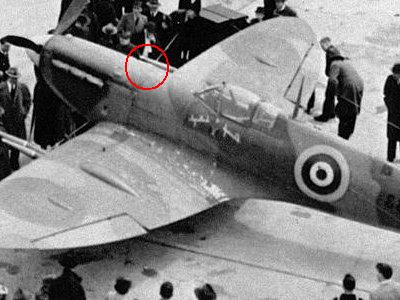 Compare the upper cowl outline with above pic (red circle). |
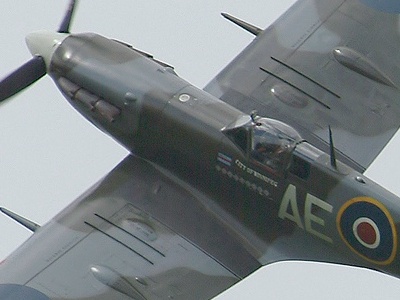 Actual restored Mk.V. |
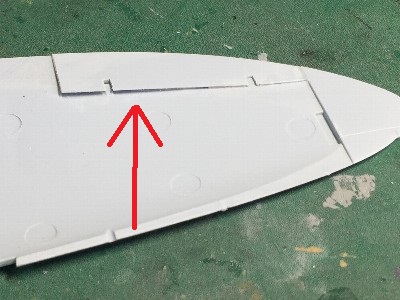 At the beginning, the aileron was tightly glued on the upper wing. Plastic sheet was inserted in the gap (red arrow). |
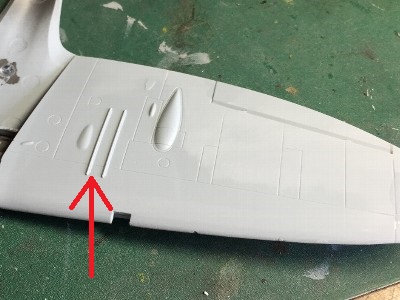 Remove reinforcement ribs (red arrow). The dihedral (6) and washout of the kit is accurate. The angle of incidence is 2(root), -8'(tip). |
|
Kit panel lines were a little wide and blurring. So all of the surface was sanded and every line was re-engraved. |
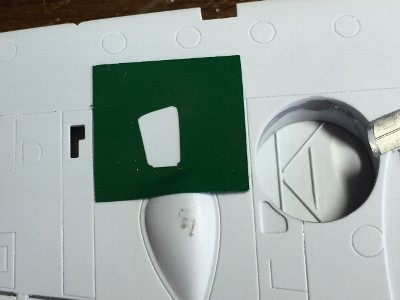 The landing light was engraved with hand-made template which was cut by a cutting machine (Graphtec Craft Robo). |
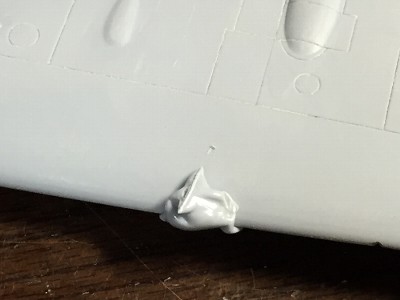 The hollow at the canon was filled with heated sprue. |
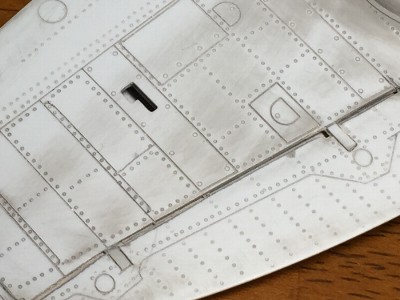 Rivets were engraved with #1 beading tool. Access panel fasteners were #4. Engine cowl fasteners were #1 on #12. |
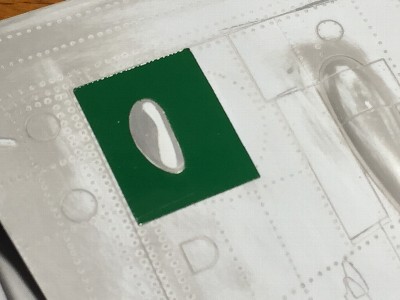 The shape of the tire blister was corrected with surfacer and Craft Robo template. |
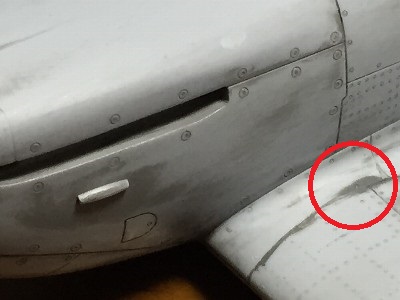 Kit parts demarcation line is different from actual filet line (red circle). |
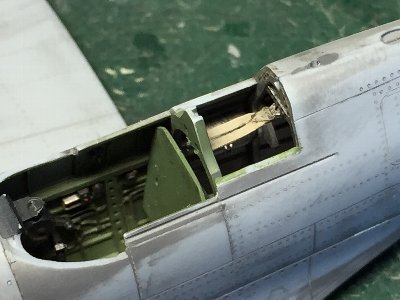 The seat belt is Fine Molds Nano Aviation. |
|
This kit distinguishes the difference of the height between early and late windscreen. This is a highly assessable point. Because, many of kits don't distinguish them. However, outline shapes of windscreen and slide hood are minor weak point of Airfix kit. As for the early windscreen, the kit bullet proof glass is thin and front shape is not correct; the width of the upper portion is too wide. As for the late wind screen, the front view shape of the rear frame is not correct; the width of the upper portion is too narrow. And the side frame of the bullet proof glass is parallel. The actual aircraft is tapered. As.for the slide hood, kit does not distinguish the difference of the length (the late hood is longer than early) and the width of the rear frame. And the demarcation line between fuselage is a little lower, therefore, the width of the hood bottom is wide. |
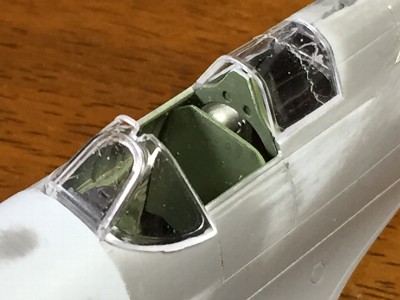 Early style windscreen. |
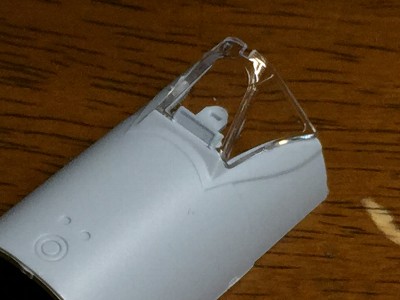 Late style windscreen. |
|
|
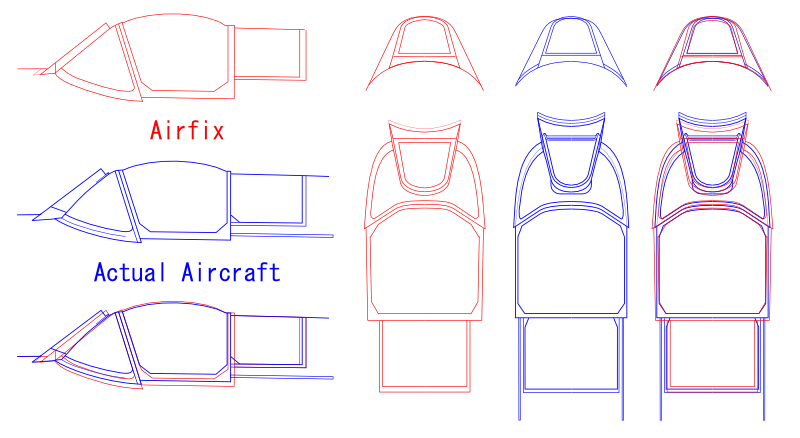 Red lines are Airfix kit and blue lines are actual aircraft. |
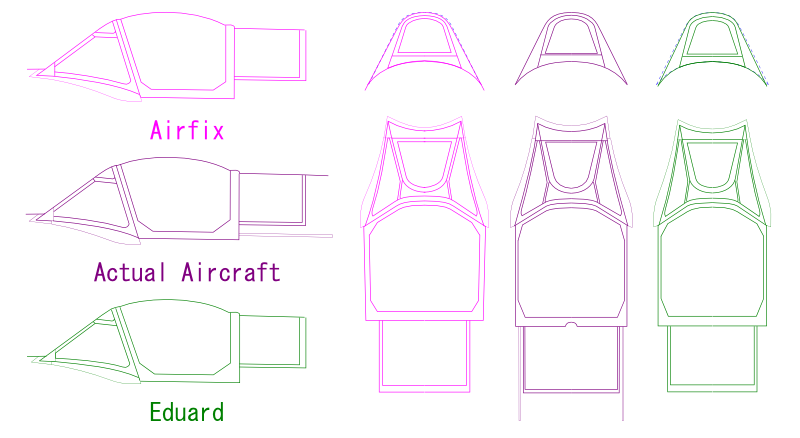 Green lines are Eduard Mk.IX and purple is Airfix. Blue dot-lines are actual aircraft. |
|
Eduard is correct as for the front shape of the bullet proof glass, but the width of the bottom is a little narrow. Anyway, these are very minor mistakes. Only Spitfire enthusiasts question these issues. So, common modelers may ignore them. |
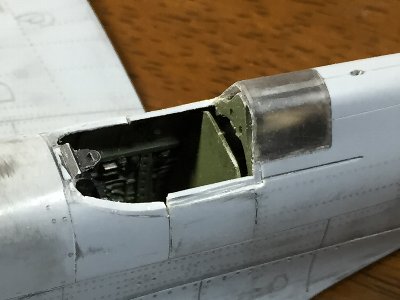 The rear fixed window was glued and sanded to be flat. Plastic piece was glued on the edge of the fuselage so as to rise the demarcation line. |
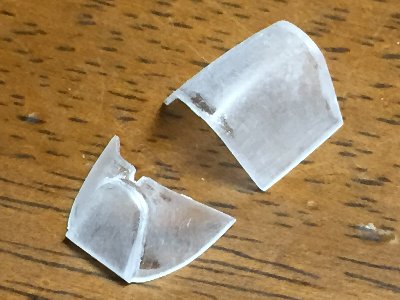 The shape of bullet proof glass was corrected. All frames were sanded to be flat. |
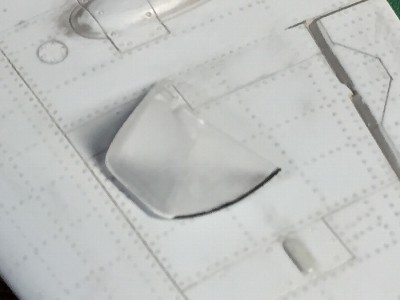 The bottom line was sanded. This black trim is a mark for sanding. |
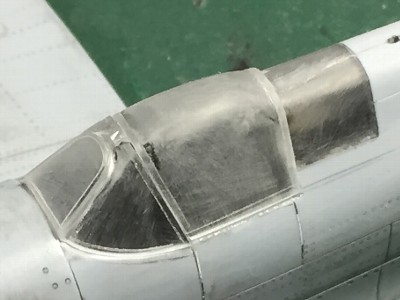 Canopy parts were almost fit to the fuselage. |
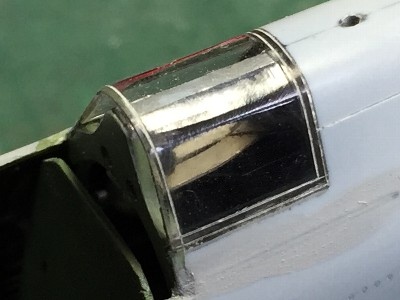 The rear window was engraved and polished. |
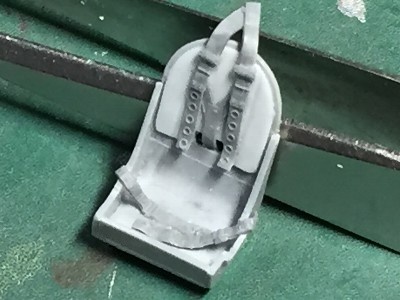 The kit pilot seat was rather poor. So the seat was scratchbuilt with plastic sheet. |
|
The thin bullet proof glass became insufferable for me. So I decided to correct it. |
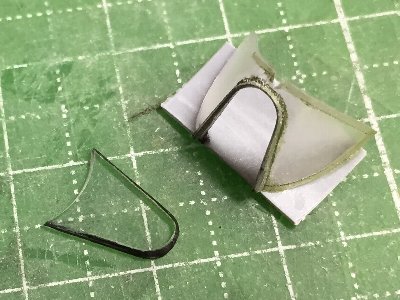 The bullet proof glass portion was cut from kit windscreen. The new bullet proof glass was cut from DVD case. |
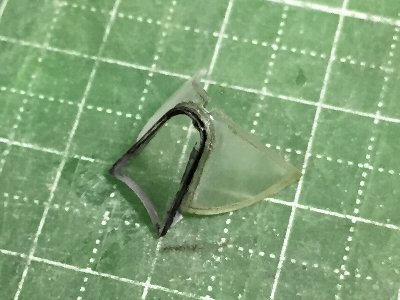 The thickness of the new glass is 1mm (0.04"). Each joint area of new bullet proof glass and kit windscreen was sanded at an angle. |
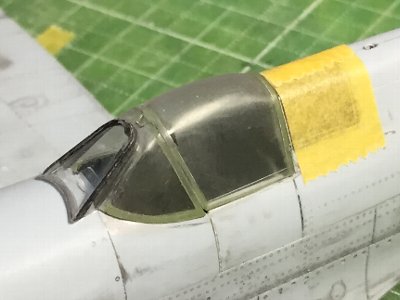 The lower portion of the new bullet proof glass was moved forward. Therefore, the angle of glass became shallow. |
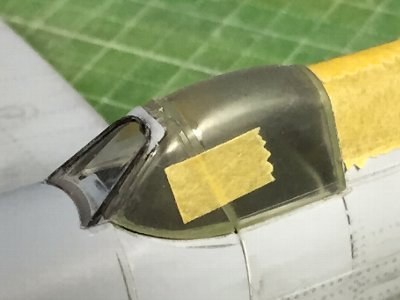 Then the rear edge of side window was cut wedgewise (0.5mm (0.02") at the lower end). And the fuselage fitting line was re-adjusted. |
|
For that matter, the kit early Mk.I windscreen is not correct as well. The flat surface portion of the actual aircraft is rectangle and it is the same as front glass. But the kit flat portion is trapezoid like bullet proof grass. That's the reason why the kit bullet proof glass is thin. |
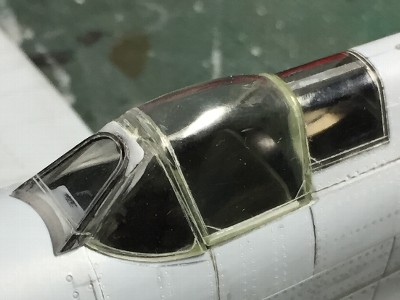 Window frames were engraved with hand-made double needles. The bullet proof glass frames were 0.3mm(0.01") gap, vertical frames were 0.4mm(0.015")gap and bottom frames were 0.6mm(0.024") gap. |
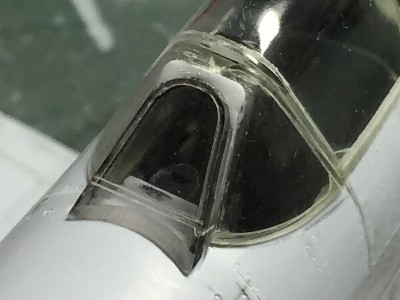 Styrene plate of a DVD case is high degree of transparency. There is no distortion. |
|
|
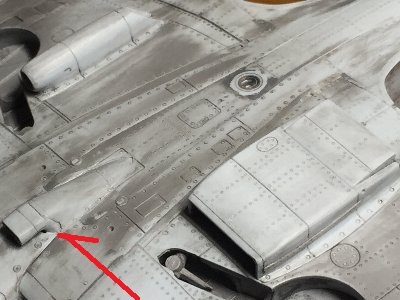 The radiator, oil cooler and air-intake were glued. |
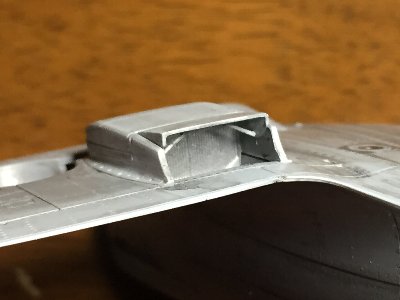 Details were added. |
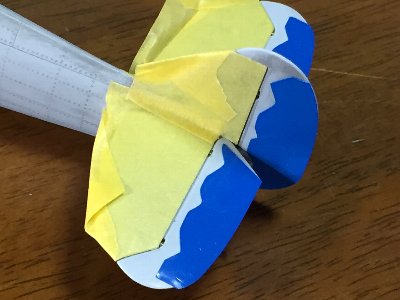 Elevator frames are depicted with surfacer. Masking sheets were cut by cutting machine. |
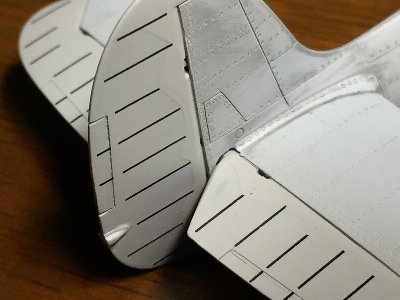 Surfacer was sprayed. Ribs were depicted with custom-made dry transfers. |
|
Some portion of the upper cowl was slightly sanded (approx 0.5mm (0.02")) to adjust its shape. Its areas were around small blisters. |
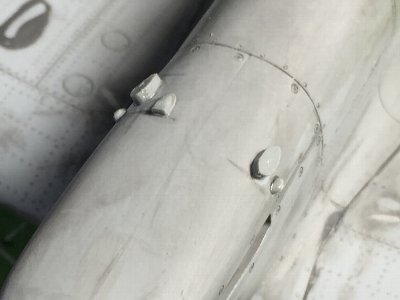 Blisters were deleted by sanding. So they were regenerated with plastic sheet. |
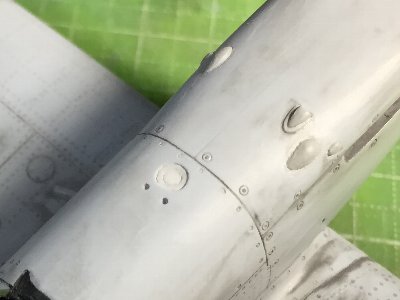 The round shapes of blisters were sanded after glued on the cowl. |
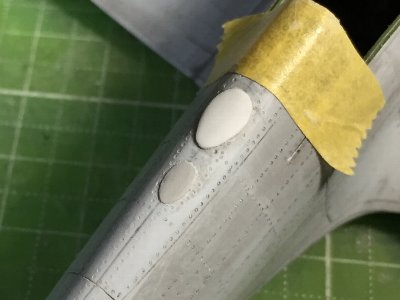 The base of antenna pole and navigation light were glued. |
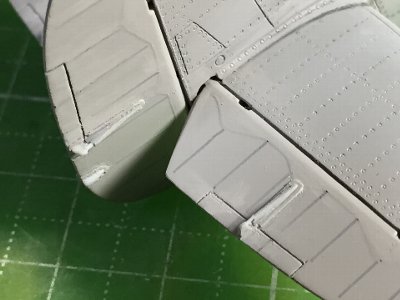 Tab rods were added. Surfacer was sprayed on dry transfers for protection. |
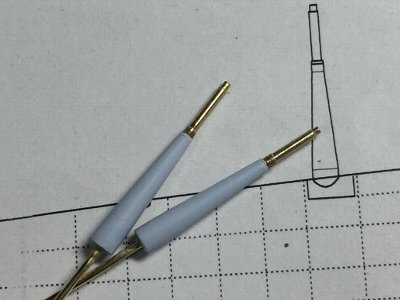 20mm cannon barrel were made of 0.7mm(0.03"), 0.9mm(0.035"), 1.1mm(0.043") brass pipe. Kit sleeve parts were sanded to be thin with a rotary tool. |
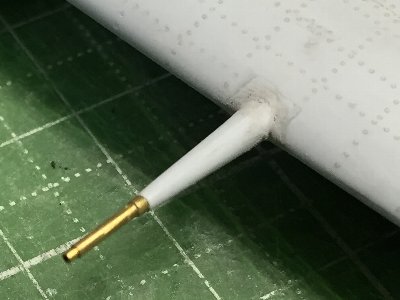 In order to form the accurate curve of wing leading edge, cannon sleeve had cut out and rejoined. |
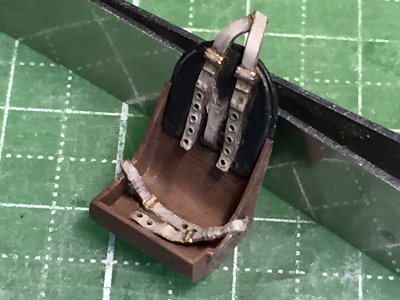 The seat was painted and weathered. |
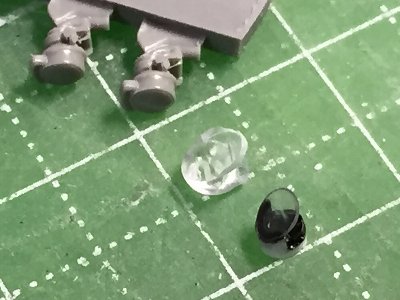 The gunsight was scratchbuilt from Evergreen plastic pipe. |
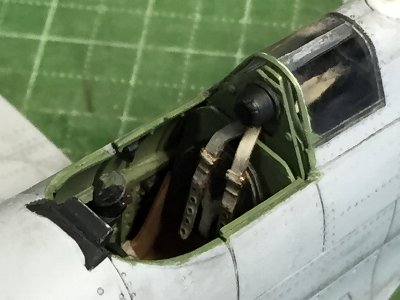 I was disappointed for the scratchbuilt seat was unnoticeable. |
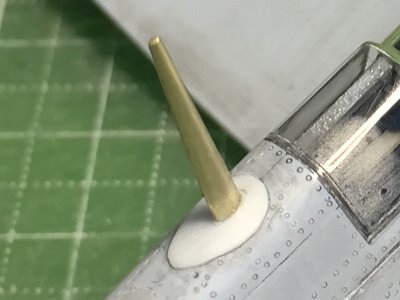 The antenna pole was made of a brass rod. |
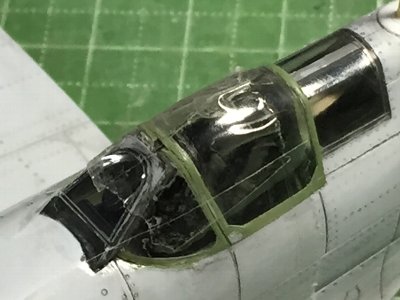 The windscreen was glued on the fuselage. |
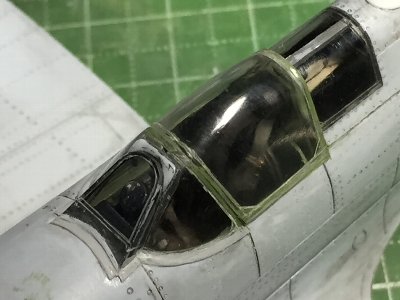 The fringe of the windscreen was made of 0.14mm (0.006") plastic sheet. |
|
The Martin Baker Hood Jettison Gear was introduced late 1941. Thus, Mk.I, II and early V didn't equip it. It consists on a metal rod, wire and lever. As for my model, only thin plastic rods were glued on the hood lower frames. |
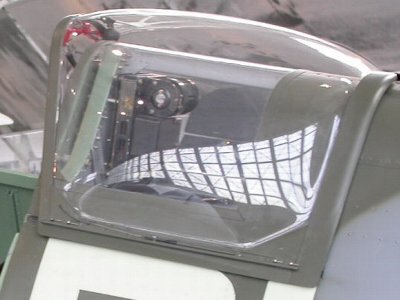 |
|
The RAF temperate camouflage scheme was changed to Dark Green / Dark Sea Grey / Medium Sea Grey in August 1941. But at that time, roundels were still old A type; they were changed in February 1942. Thus, both new greyish camouflage and old roundels had existed only a half year, and only Mk.V was just in front-line service at this period. There are not so many photos of Mk.V in such scheme. Especially, there are very few photos which clearly show the code letter and serial. Finally, I selected JH-H/BL627 of no 317 Squadron. Other candidates were 610 Sqn DW-X/BL574 and 315 Sqn PK-M/AD230. The former has no special markings. The latter has PAF insignia on the nose and the serial is very small size and painted upper portion of the sky band. Get back to JH-H/BL627, the port side photo can be seen in Mushroom Yellow Series "Spitfire Mk.V". The starboard code letter can be presumed as H-JH from other aircraft of this squadron. "WONOSOBO" may be painted on the both side of fuel tank. "WONOSOBO" is a name of place in Java. This means Presentation Aircraft. At this period, the size of yellow identification bands on wing leading edges was not strictly applied but varied with each squadron. As for 317 Sqn, I don't know it. So my model is presumption. When the new camouflage was ordered, old brownish camouflaged aircraft were re-painted. However, Dark Sea Grey paint was not sufficient, then Mixed Grey - mixture of Night and White - was used. Was BL627 painted DSG or Mixed Grey? That is a question. BL627 was built in January 1942: five months after the order. So I guess DSG paint was applied at the factory. And I guess the sky band and serials was factory finish as well. And if so, caution stencils were steadily applied as well. By the way, there are photos of another JH-H of 317 Sqn. in Osprey "Polish Aces of WW2". This aircraft is CBAF built Mk.Vb AD140. The slide hood was balloon type, the rhombus squadron mark was painted under the antenna pole, PAF insignia was on the cowl side and no presentation aircraft letter. Other scheme is the same as BL627. According to Osprey Polish Aces, this aircraft was flown by Wg.Cdr. Witorzenc. So, BL627 might be the same. AD140 was written off on March 15 1942, and BL627 arrived at 317 Sqn on February 17. What do you think? The camouflage pattern of Spitfire changed slightly from Mk.I to late marks. So I collected many of Mk.V's photos and break down the typical pattern of Mk.V. This is shown in the following figure. |
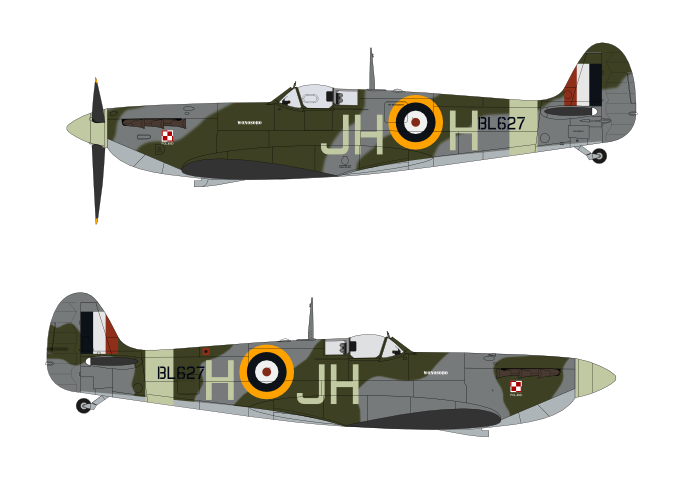 |
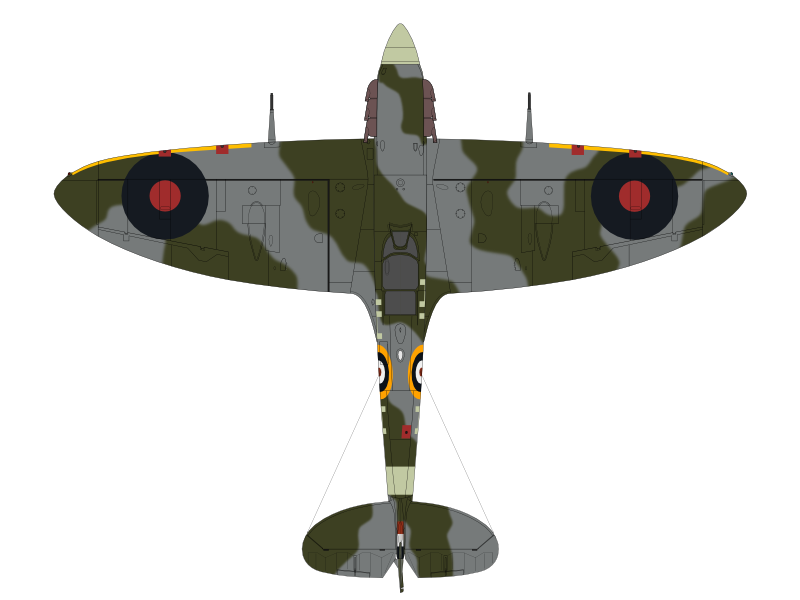 |
|
I drew color illustrations in a familiar way. The first aircraft is my selected markings of CBAF built Mk.Vb s/n BL627 flown by Wg.Cdr. Witorzenc (presumption) of the 317th Squadron (Poland) in early 1942. BL627 was built in January 1942, sent to 317 Sqn in February and was written off July 1942 by damage in service. The second one is Supermarine built Mk.Vb AA834 of the 403rd Squadron (Canada). AA834 was built in September 1941. Letters on the starboard is X-KH and the port side is presumption. Note the short spinner, de Havilland metal blades and flat side slide hood. Positions of fuselage roundel, serial number and sky band are different between CBAF and Supermarine. |
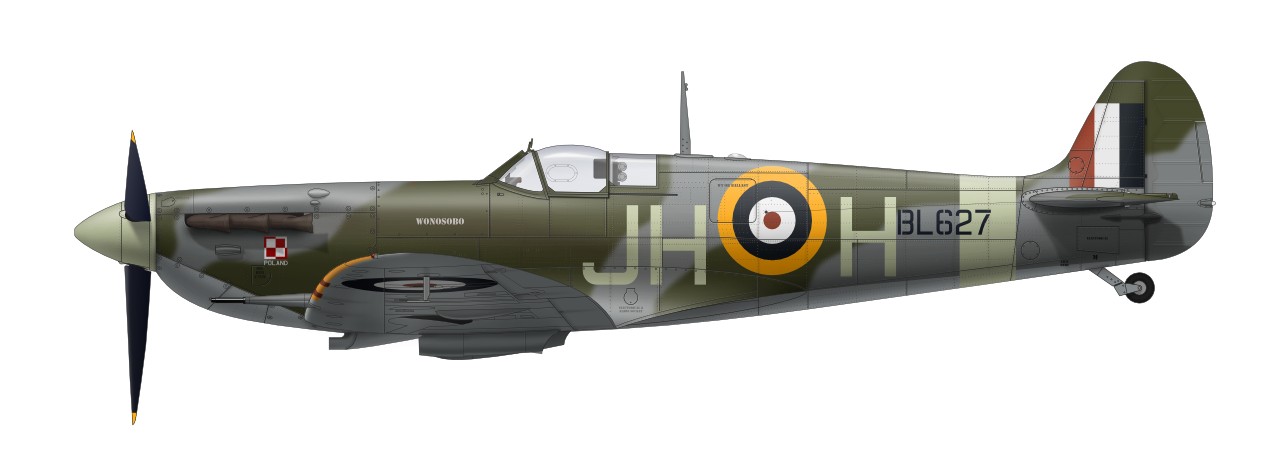 |
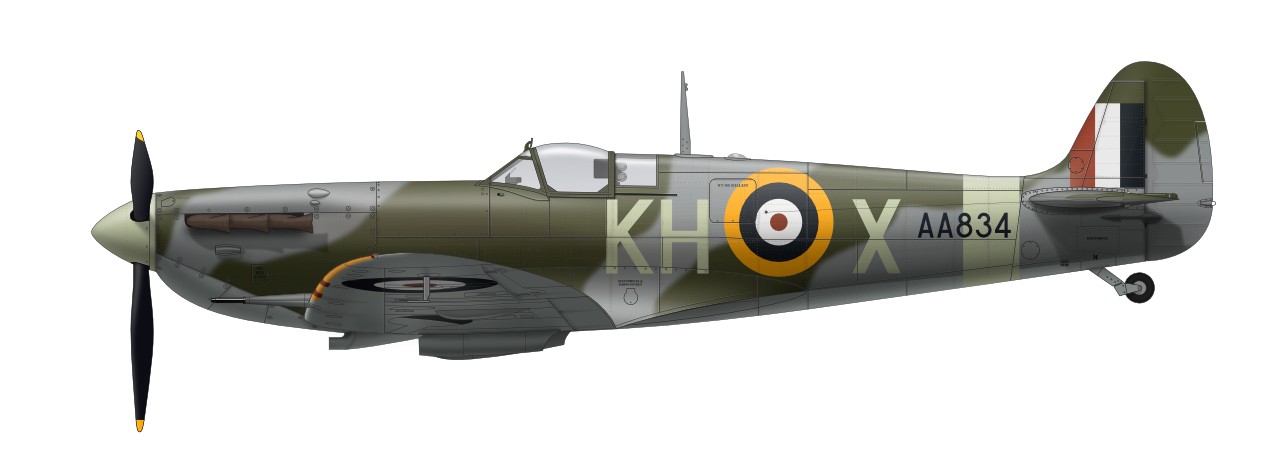 |
|
|
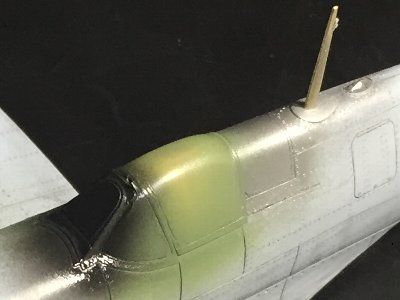 The slide hood was temporarily fixed with polyvinyl acetate glue for painting works. First of all, interior colors were applied. |
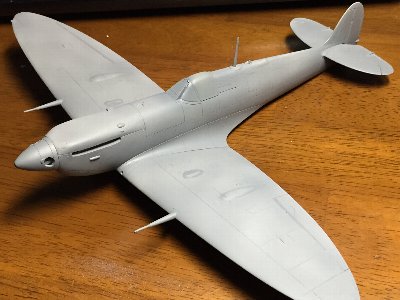 Next, surfacer was thinly over sprayed. Small bulge were added on the spinner. |
|
Engraved rivets of beading tools were very delicate. So I took care not to paint thickly and not to fill rivets. |
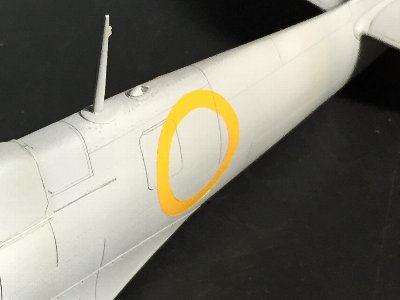 First, Orange Yellow was masked and painted on surfacer. |
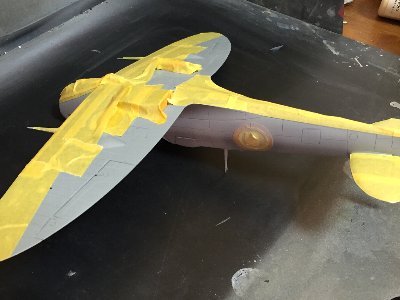 Next, Medium Sea Grey was sprayed. |
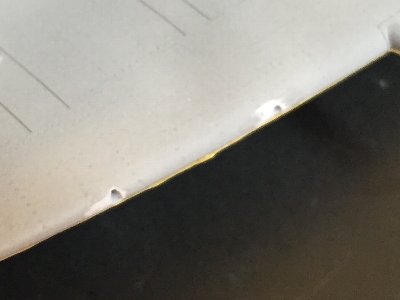 Oops, I forgot gun muzzles. |
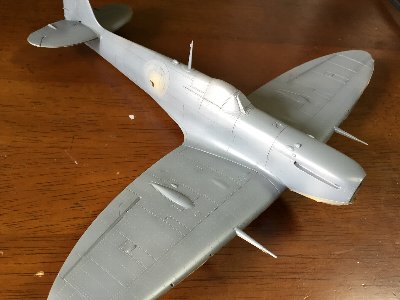 Dark Sea Grey was painted. |
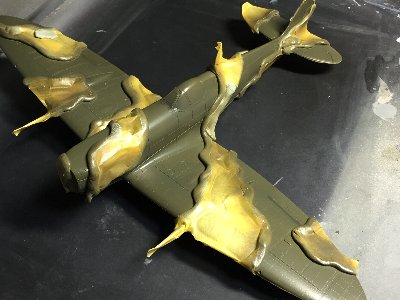 Dark Green was sprayed. Demarcation lines were Blu-Tack. |
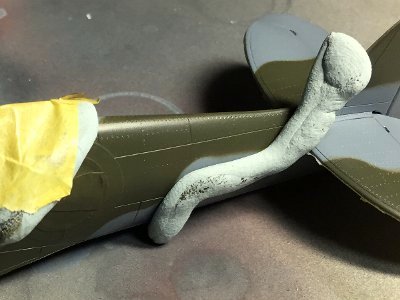 Oops I made a mistake. |
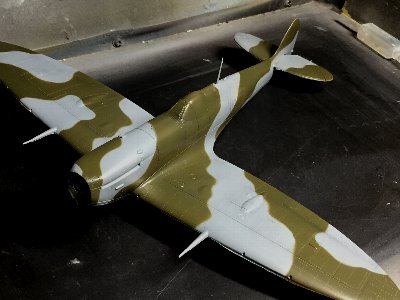 Camouflage paint was finished. |
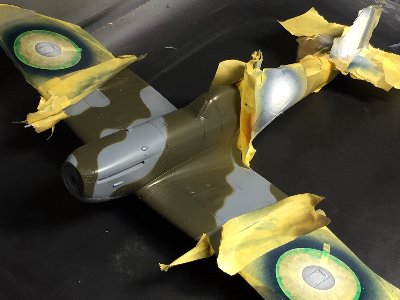 Dull Blue was painted, then blue portion was masked and White was sprayed. Each color was not painted on and on but side by side. |
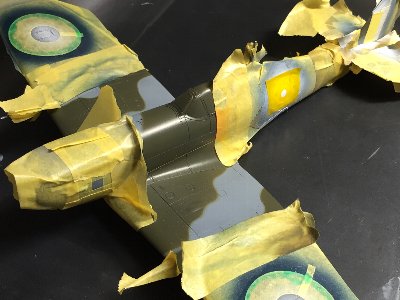 Masking for Dull Red was 3mm (0.12") scotch tape. |
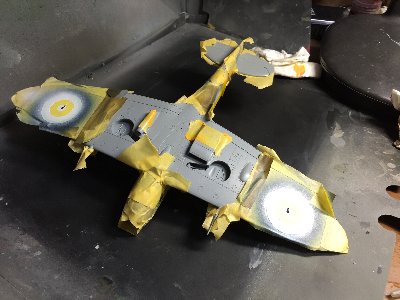 Maskings for Dull Red of the lower surface were finished. |
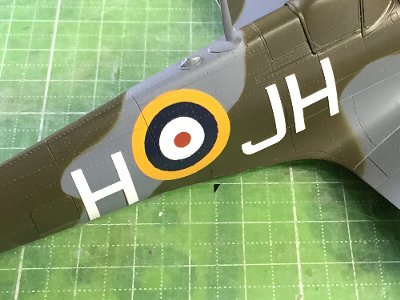 This is not painting but positioning for masking sheets. |
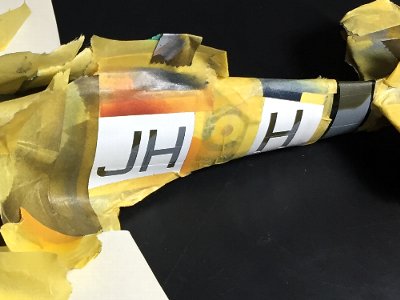 Masking sheets for code letters were cut with a cutting machine. |
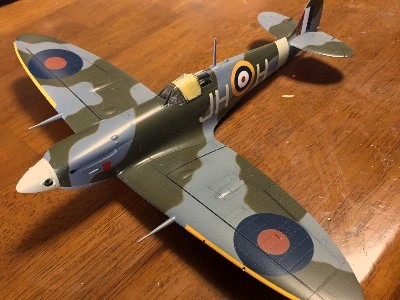 The Red square for PAF insignia and Night walk way were masked and painted as well. |
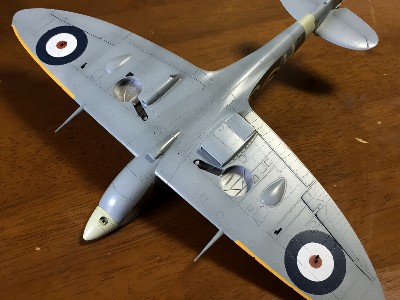 The wheel bay was painted dark silver. Then, painting works were finished. |
|
|
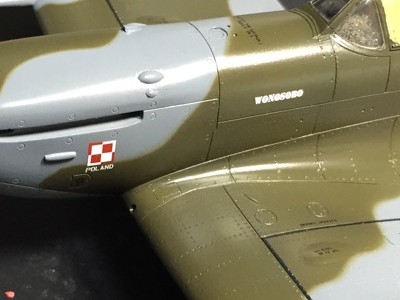 Serial numbers, PAF insignia (white portion), "WONOSOBO" and caution stencils were custom-made dry transfers. |
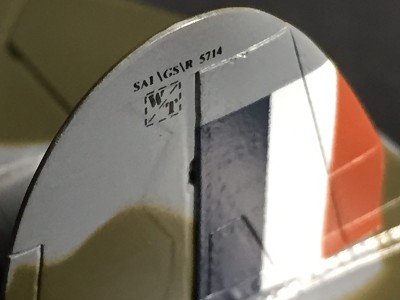 Small letters can be read, but numbers are not correct. It is only an atmosphere. |
|
The atmosphere of kit propeller blade is good. Especially, the thickness of the root is excellent. However the kit modelizes restored aircraft. So, it is not correctly replicated actual WW2 Mk.V's Rotol blade. The correct blade shape is described in my front view drawings with red line. I cut this print out and stuck on the kit blade. The diameter of Mk.V's propeller is described 10'3" by some references. But when I calculated it from original WW2 photos by proportion to spinner diameter, it became 10'5" approx. So, my model was made as 10'5" size. (For your information, Griffon Spitfire Mk.XIV and Seafire Mk.XV are 10'5".) |
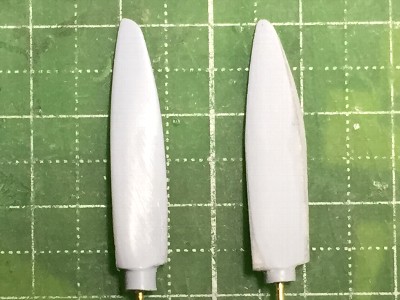 The left is kit original blade. The right is under repair. |
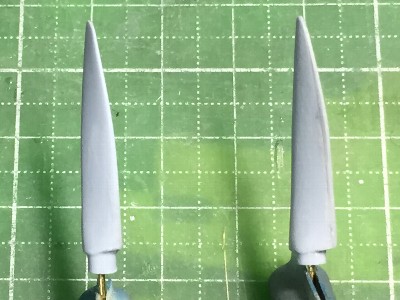 The left is kit. The right is under repair. Note the width of the root, the shape of the tip and the curve of the leading edge. |
|
The kit tire is a little thin. So I bought Eduard Brassin resin tire. But, its diameter is too small by 1mm(0.04")!! Hasegawa Mk.V is correct in a diameter and width. |
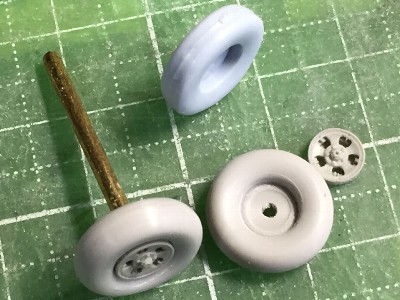 The wheel of Hasegawa Mk.V's tire was cut with rotary tool and Eduard's hub was inserted. |
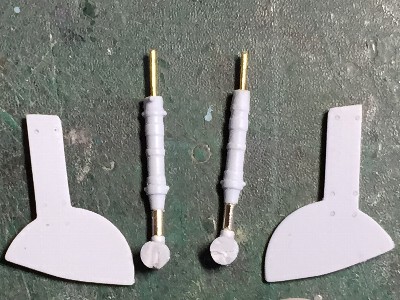 0.8mm (0.03") brass rod was inserted through the gear leg center for reinforcement. The oleo strut was 1.2mm(0.05") plate pipe. |
|
|
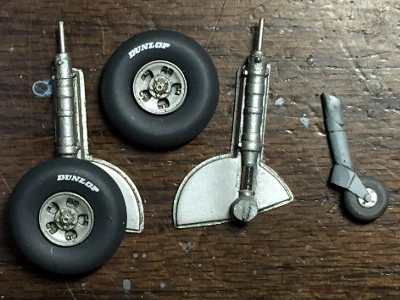 The gear leg, inside of gear cover and wheel were painted silver. "DUNLOP" is custom-made dry transfers. |
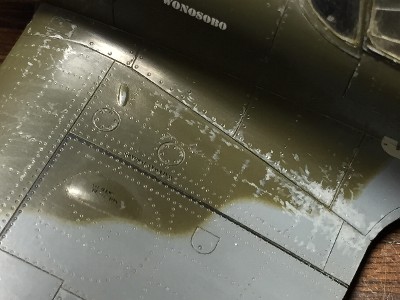 Chipping of Medium Sea Grey was applied with fine brush on the wing root. I don't use silver as usual. |
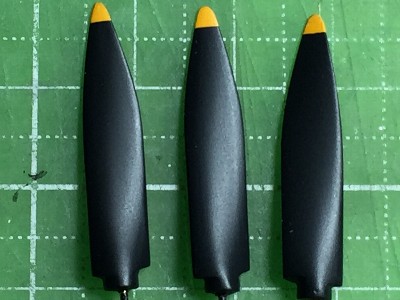 Propeller blades were finished. The left and center are front side, the right is back side. |
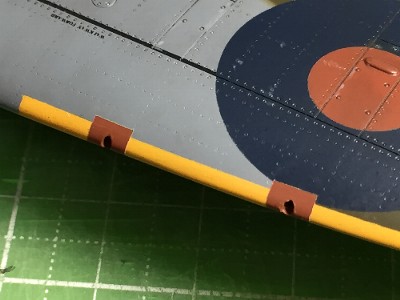 Dull Red muzzle tape was painted. |
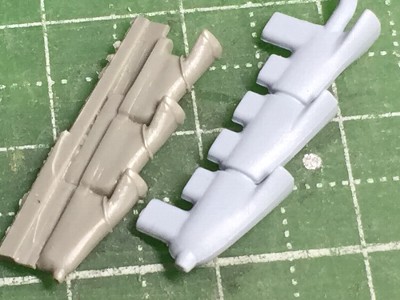 The shape of kit exhaust is superior to any other resin parts for example Quick Boost. Note the volume of inner portion. |
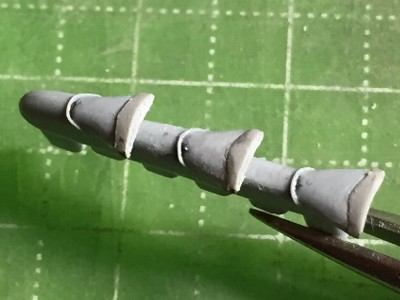 The kit parts lacks details, so I added them with thin plastic sheet and extended sprue. |
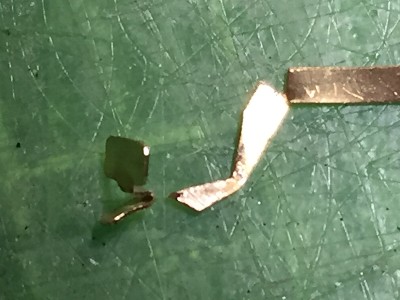 The rear view mirror was made of brass plate with solder. It consists of three parts: mirror, sole plate and stay. It's impossible to solder three parts at one time. So, the mirror and sole plate were unified. Then they became two parts. |
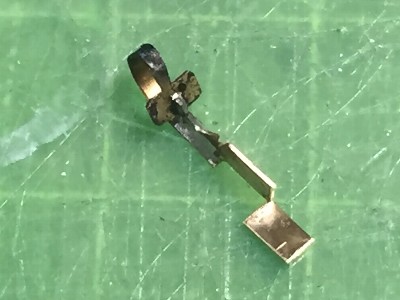 The stay was soldered to unified mirror and sole. Then the mirror and sole were cut. The left pic is too near to cut. So the way of unifying was changed to above pic. |
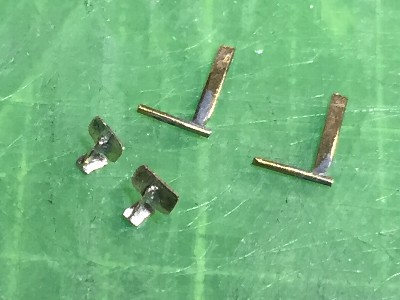 It was not easy to solder the stay to the exact center of mirror and sole. So the mirror and sole were cut a little large and trimmed with file after soldering. |
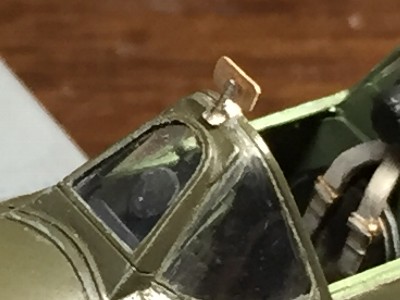 The rear view mirror was glued on the windscreen. Hasegawa Mirror Finish was attached on the back side. |
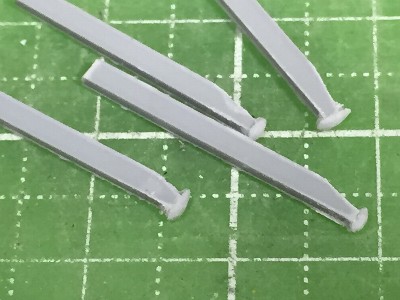 Small blisters of wing guns were reproducted with plastic sheet. |
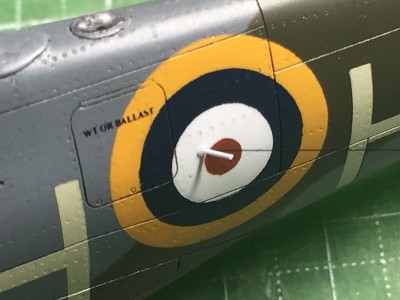 The IFF antenna wire was glued at the small hole with extended sprue. |
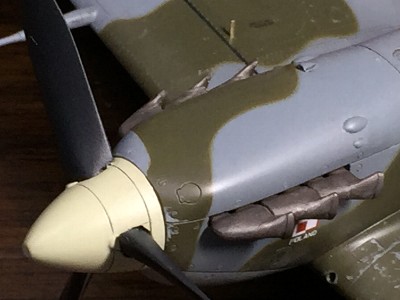 The exhaust stacks was painted and weathered with Tamiya Weathering Masters. |
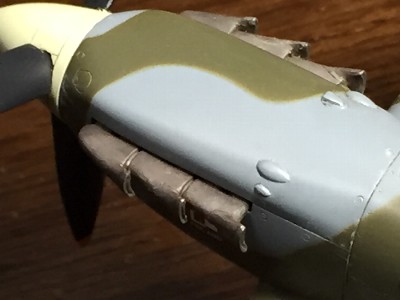 Slits were engraved on the rear end of exhaust stacks with carving knifes. Be aware that left and right kit exhaust parts are not fixed in parallel. The front end is wider than the rear. So the base was sanded at a slant. |
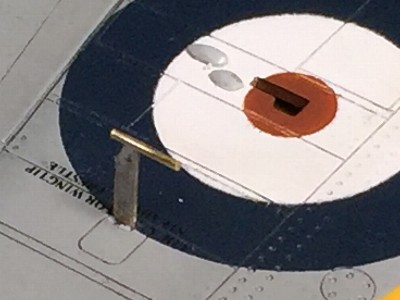 The pitot tube was made of brass rods. |
 The locking ring was made of 0.3mm(0.01") plastic sheet. Drop tank hooks were kit parts. |
 Lately, I use the box for the deck at detailing works. |
 Detailing works were almost finished. The knock out panel of the port slide hood was made of Evergreen 0.13mm(0.005") transparent plastic sheet. It was cut, polished with rubbing compound and glued with Future wax. |
|
Finally, my Mk.V was completed. The outline shape of this kit is very good and I enjoyed modeling. |
 |
 |
 |
 |
 |
 |
|
The first illustration is Mk.Vc ES252/ZX-E flown by Sqn Ldr Lance Wade of 145 Sqn in North Africa, Spring of 1943. The serial shows this aircraft was build at CBAF but de Havilland propeller was retro fit. The spinner is the common short type. The lower side is dark in the photo, so there is a possibility of Dark Mediterranean Blue. I tentatively painted Azure Blue of majority. I guess the starboard code letter as ZX-E according to other aircraft of 145 Sqn. |
 |
|
The second one is Westland built Mk.Vc EF543/ZP-P flown by Lt Don MacLean of RAAF 457sqn. The starboard code letter is ZP-P, the serial is over painted. The port one is presumption from other aircraft. The propeller blade is wide and the spinner may be a little long. |
 |
|
The third is CBAF built trop Mk.Vc ES317/MX-F flown by 1st Lt Ron Brown of USAF 307FS, Sicily, July 1943. The starboard letter may be MX-F; M is painted on the serial, with dish type wheel cap. Note differences of three spinners and blades. |
 |
|
Next one is CBAF built Mk.Vb EN951/RF-D flown by Sqn Ldr Jan Zumbach, CO of No 303 Sqn, in 10-11 1942. The cartoon of Donald Duck is illustrated as "without distortion". So you can use my illustration as a master for custom made decals. If you have original photo (see Osprey Aircraft of the Ace 16 Spitfire Mk V Aces p.28), compare each height of Donald's face. He flew at least three Donald Duck aircraft. All of them equipped the high rear view mirror and balloon type slide hood. |
 |
|
The last one is CBAF built Mk.Vb AD140/JH-H flown by CO of 317Sqn Wg Cdr Witorzenc. This aircraft also has the balloon canopy. |
 |
|
I list up major modifications of the Mk.V quoted from "Spitfire the History" Key Publishing. "*" is from other references below. * 3/41 First Supermarine built Mk.V delivered * 5/41 Late style windscreen introduced in Supermarine * 6/41 First CBAF built Mk.V delivered 8/ 9/41 Exhaust gun heating system introduced only for Vb 8/29/41 30gal drop tank introduced 11/10/41 New camouflage scheme introduced 11/18/41 Matin Baker hood jettison gear introduced * 1/42 First Supermarine built Mk.V trop. delivered * 2/42 C type roundel ordered (application in units delayed until 6/42) 5/5/42 Landing light deleted * 5/42 First CBAF built Mk.V trop. delivered * 5/42 Late style windscreen introduced in CBAF *6/42 First Supermarine built Mk.IX delivered 6/16/42 Head pad deleted 8/42 Last Supermarine built Mk.V delivered 8/11/42 Signal port deleted 7/43 Last CBAF built Mk.V delivered
|
|
The photo of Mk.Vb JH-H/BL627 is in ref-41 "Yellow Series Supermarine Spitfire Mk V, ISBN 83-917178-3-6 Mushroom Model Publications". Another JH-H/AD140 is in ref-66-1,-49. |
| 1 | The famous airplane of the world (new edition) No.102 Spitfire | 4-89319-104-7 | Bunrindo |
| 2 | The famous airplane of the world (new edition) No.25 Spitfire | - | Bunrindo |
| 3 | The famous airplane of the world (old edition) Spitfire Mk.I-XVI | - | Bunrindo |
| 4 | The famous airplane of the world (old edition) Spitfire Mk.XII-24 | - | Bunrindo |
| 5 | Koku Fun Illustrated No.111 Luftwaffe and RAF in WW2 | - | Bunrindo |
| 6 | Koku Fun Illustrated No.93 Veterans | - | Bunrindo |
| 7 | Koku Fun Additional Volume Air Combat No.5, No.6 | - | Bunrindo |
| 8 | Aero Detail 8 Supermarine Spitfire Mk.I`V | 4-499-22617-1 | Dainippon Kaiga |
| 9 | Aero Detail 27 Merlin Spitfire Mk.VI`XVI | 4-499-22709-7 | Dainippon Kaiga |
| 10 | Aero Detail 30 Griffon Spitfire | 4-499-22741-0 | Dainippon Kaiga |
| 11 | Osprey Military Aircraft Series Aces of Spitfire Mk.I/II 1939-1941 | 4-499-22739-9 | Dainippon Kaiga |
| 12 | Osprey Military Aircraft Series Aces of Spitfire Mk.V 1941-1945 | 4-499-22810-7 | Dainippon Kaiga |
| 13 | Aces of the RAF | - | Sensha Magazine |
| 14 | Model Art Extra Number 387Spitfire | - | Model Art |
| 15 | Spitfire in action aircraft no.39 | 0-89747-092-3 | Squadron/Signal Publications |
| 16 | Waffen Arsenal 36 Spitfire | 3-7909-0064-8 | Waffen Arsenal |
| 17 | The Spitfire Story | 1-85409-172-7 | Arms and Armour Press |
| 18 | Warbird History Spitfire | 0-7603-0300-2 | Motorbooks International |
| 19 | Supermarine Spitfire | 0-86124-140-1 | Bison Books |
| 20 | Spitfire at War | - | Ian Allan |
| 21 | Sie flogen die Spitfire | - | Motor Buch Verlag |
| 22 | From the Cockpit Seafire | - | Ad Hoc Publications |
| 23 | Supermarine Seafire | 978-1-86126-990-4 | Crowood |
| 24 | Warpaint 20 Supermarine Seafire | - | Hall Park Books |
| 24-2 | Warpaint 78 Vickers Supermarine Merlin Seafire | - | Hall Park Books |
| 25 | Spitfire Flying Legend | 1-84176-210-5 | Osprey |
| 26 | Monografie Lotnicze 38 Supermarine Spitfires cz.1 | 83-86209-75-9 | AJ-Press |
| 27 | Monografie Lotnicze 39 Supermarine Spitfires cz.2 | 83-86208-76-7 | AJ-Press |
| 28 | Monografie Lotnicze 40 Supermarine Spitfires cz.3 | 83-86208-77-5 | AJ-Press |
| 29 | Monografie Lotnicze 71 Supermarine Spitfires cz.4 | 83-7237-079-6 | AJ-Press |
| 30 | Warbird Tech 32 Griffon-Powered Spitfires | 1-58007-045-0 | Specialty Press |
| 31 | Warbird Tech 35 Merlin-Powered Spitfires | 1-58007-057-4 | Specialty Press |
| 32 | Modellers Datafile 3 The Supermarine Spitfire part1 Merlin-Powered | 0-9533465-2-8 | SAM Publications |
| 33 | Modellers Datafile 5 The Supermarine Spitfire part2 Griffon-Powered | 0-9533465-4-4 | SAM Publications |
| 33-2 | Classic Warbirds 1 Spitfire Star of Israel | 0-9583594-0-7 | Ventura Publishing |
| 33-3 | Classic Warbirds 2 Spitfire The ANZACS, The RAF through Colonial eyes | 0-9583594-1-5 | Ventura Publishing |
| 34 | Classic Warbirds 3 American Spitfire camouflage and markings (Part 1) | 0-9583594-3-1 | Ventura Publishing |
| 35 | Classic Warbirds 4 American Spitfire camouflage and markings (Part 2) | 0-9583594-4-x | Ventura Publishing |
| 35-2 | Classic Warbirds 5 From D-Day to Victory! Fighters in Europe 1944-45 | 0-9583594-2-3 | Ventura Publishing |
| 36 | Classic Warbirds 6 Early Mk.IXs, Pacific Corsairs, Green Ghost Beaufighters | 0-9583594-5-8 | Ventura Publishing |
| 36-2 | Classic Warbirds 7 USAAF Spitfires, Bader's Mk.V, RAAF B-24s, Boomerangs | 0-9583594-7-4 | Ventura Publishing |
| 37 | Classic Warbirds 10 Merlin PR Spitfires | 0-9582296-2-7 | Ventura Publishing |
| 38 | Classic Warbirds 11 Merlin PR Spitfires in detail | 0-9582296-5-4 | Ventura Publishing |
| 39 | Supermarine Spitfire PR Mk.XIX | - | MPM |
| 40 | Aerodata International No2 Supermarine Spitfire I&II | 0-905469-25-9 | Vintage Aviation Publications |
| 41 | Yellow Series Supermarine Spitfire Mk V | 83-917178-3-6 | Mushroom Model Publications |
| 42 | 4+ Vickers-Supermarine Spitfire F Mk.22/24 | 80-86637-03-4 | Mark I |
| 43 | Spitfire Mks VI-F.24 | 1-84037-400-4 | Airlife Publishing |
| 44 | Aircam Aviation Series No4 Supermarine Spitfire Mk.I-XVI | - | Osprey Publishing |
| 45 | Aircam Aviation Series No8 Supermarine Spitfire Mk.XII-24 | - | Osprey Publishing |
| 46 | Aircraft of the Ace 5 Late Marque Spitfire Aces 1942-45 | 1-85532-575-6 | Osprey Publishing |
| 47 | Aircraft of the Ace 12 Spitfire Mk I/II Aces 1939-41 | 1-85532-627-2 | Osprey Publishing |
| 48 | Aircraft of the Ace 16 Spitfire Mk V Aces 1941-45 | 1-85532-635-3 | Osprey Publishing |
| 49 | Aircraft of the Ace 21 Polish Aces of World War 2 | 1-85532-726-0 | Osprey Publishing |
| 49-2 | Aircraft of the Ace 74 Soviet Lend-Lease Fighter Aces of WW 2 | 978-1-84603-041-3 | Osprey Publishing |
| 50 | Aircraft of the Ace 75 Royal Navy Aces of WW 2 | 978-1-84603-178-6 | Osprey Publishing |
| 50-2 | Aircraft of the Ace 80 American Spitfire Aces of WW 2 | 978-1-84603-202-8 | Osprey Publishing |
| 51 | Aircraft of the Ace 81 Griffon Spitfire Aces | 978-1-84603-298-1 | Osprey Publishing |
| 51-2 | Aircraft of the Ace 83 Malta Spitfire Aces | 978-1-84603-305-6 | Osprey Publishing |
| 52 | Aircraft of the Ace 87 Spitfire Aces of Burma and the Pacific | 978-1-84603-422-0 | Osprey Publishing |
| 53 | Aircraft of the Ace 98 Spitfire Aces of North Africa and Italy | 978-1-84908-343-0 | Osprey Publishing |
| 53-2 | Aircraft of the Ace 113 V1 Flying Bomb Aces | 978-1-78096-292-4 | Osprey Publishing |
| 53-3 | Aircraft of the Ace 122 Spitfire Aces of Northwest Europe 1944-45 | 978-1-78200-338-0 | Osprey Publishing |
| 53-4 | Aircraft of the Ace 127 Polish Spitfire Aces | 978-1-4728-0837-0 | Osprey Publishing |
| 53-5 | Aircraft of the Ace 131 Spitfire Aces Of The Channel Front 1941-43 | 978-1-4728-1258 2 | Osprey Publishing |
| 54 | Aviation Elite 3 No 91 'Nigeria' Squadron | 1-84176-160-5 | Osprey Publishing |
| 55 | Aviation Elite 9 No43 'Fighting Cocks' Squadron | 1-84176-439-6 | Osprey Publishing |
| 56 | Aviation Elite 30 4th Fighter Group 'Debden Eagles' | 978-1-84603-321-6 | Osprey Publishing |
| 57 | Aviation Elite 35 No 126 Wing RCAF | 978-1-84603-483-1 | Osprey Publishing |
| 58 | Osprey Duel 16 Seafire vs A6M Zero Pacific Theatre | 978-1-84603-433-6 | Osprey Publishing |
| 58-2 | Osprey Duel 60 Spitfire V vs C.202 Folgore | 978-1-78200-356-4 | Osprey Publishing |
| 59 | On Target Profiles 4 Spitfires Mk I to VI in the European Theatre of Operations | 1-904643-03-5 | The aviation Workshop Publications |
| 60 | On Target Profiles 8 Photo Reconnaissance Spitfires in Worldwide Service | 1-904643-15-9 | The aviation Workshop Publications |
| 61 | On Target Special 2 Britain Alone June 1940 to December 1941 | 1-904643-06-X | The aviation Workshop Publications |
| 62 | On Target Special 9 The Battle of Britain Comouflage & Markings 1940 | 97-81904-643364 | The aviation Workshop Publications |
| 63 | 4th Fighter Group in World War II | 0-89747-515-1 | Squadron/Signal |
| 64 | Polish Air Force 1939-1945 | 0-89747-324-8 | Squadron/Signal |
| 65 | Fleet Air Arm British Carrier Aviation, 1939-1945 | 0-89747-432-5 | Squadron/Signal |
| 66 | Britain's Fleet Air Arm In World War II | 0-7643-2131-5 | Schiffer |
| 66-1 | Polish Air Force at War vol.1 1939-1943 | 0-7643-0559-X | Schiffer |
| 67 | Blue series 315 (Polish) Squadron "Deblin" | 83-89450-00-3 | Mushroom Model |
| 68 | 2nd Tactical Air Force Volume One | 1-903223-40-7 | Classic |
| 69 | 2nd Tactical Air Force Volume Two | 978-1-906537-01-2 | Classic |
| 70 | 2nd Tactical Air Force Volume Three | 1-903223-60-1 | Classic |
| 71 | 2nd Tactical Air Force Volume Four | 1-903223-41-5 | Classic |
| 72 | American Eagles 1 American Volunteers of the RAF 1937-1945 | 1-903223-16-4 | Classic |
| 73 | Eyes for the Phoenix Allied Aerial Photo Reconnaissance Operation in South-East Asia 1941-45 | 0-9519899-4-4 | Hikoki Publications |
| 74 | Spitfires and Yellow Tail Mustangs 52nd Fighter Group in Warld War Two | 1-902109-43-0 | Hikoki Publications |
| 75 | White Eagles Aircraft, Men & Operations of the Polish Air Force 1918-1939 | 1-902109-10-4 | Hikoki Publications |
| 76 | RAAF Camouflage & Markings 1939-45 Vol1 | - | Kookaburra Technical Publications |
| 77 | RAAF Camouflage & Markings 1939-45 Vol2 | 0-85880-037-3 | Kookaburra Technical Publications |
| 78 | The spitfire, Mustang and Kittyhawk in Australian service | 0-9587978-1-1 | Aerospace Publications |
| 79 | Red Stars In The Sky 1 Soviet Air Force In World War Two | 951-9035-50-8 | Tietoteos |
| 80 | Korean Air War | 0-7603-1511-6 | Motorbooks International |
| 81 | The Royal Air Force Of World War Two In Colour | 1-85409-185-9 | Arms And Armour |
| 82 | War Eagles in Original Color | 0-9629359-2-1 | Widewing |
| 83 | Camera Above The Clouds Volume 1 | 0-906393-31-0 | Airlife Publishing |
| 84 | Camera Above The Clouds Volume 2 | 0-906393-50-7 | Airlife Publishing |
| 85 | Camera Above The Clouds Volume 3 | 1-85310-369-1 | Airlife Publishing |
| 86 | Spitfire Mk. IX & XVI Engineered | 978-0-9784001-0-1 | Monforton Press |
| 87 | The Spitfire V Manual | 0-85368-420-0 | Arms and Armour Press |
| 88 | Spitfire The History | 0-946219-10-9 | Key Publishing |